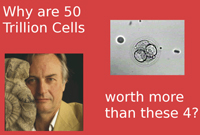Robert P. George & Christopher Tollefsen, who wrote the book, Embryo: A Defense of Human Life, have a column on National Review answering a review of the book by William Saletan of Slate magazine.  Having not read the review, I can only gather by this column that Saletan’s main point was that a human embryo is not yet a complete and separate “being” though he still thinks that human embryos “deserve our respect” and that “we should never create or destroy them lightly.” It sounds like Saletan was trying to find that frantically sought after “middle ground” in debates such as this – complimenting the other side and sympathizing with their point of view, while suggesting that some sort of ethical compromise can be made. But when it comes to the treatment and respect for human life it’s all or nothing – no compromise, no middle ground. Human beings are unique, exceptional and sacred and should always be treated as such at any stage of development.
Having not read the review, I can only gather by this column that Saletan’s main point was that a human embryo is not yet a complete and separate “being” though he still thinks that human embryos “deserve our respect” and that “we should never create or destroy them lightly.” It sounds like Saletan was trying to find that frantically sought after “middle ground” in debates such as this – complimenting the other side and sympathizing with their point of view, while suggesting that some sort of ethical compromise can be made. But when it comes to the treatment and respect for human life it’s all or nothing – no compromise, no middle ground. Human beings are unique, exceptional and sacred and should always be treated as such at any stage of development.
Most of this rebuttle column is a look into scientific embryology, but I particularly enjoyed it when George and Trollefsen used Saleten’s own self against him:
Consider any adult human being—William Saletan, for example. He is the same whole living individual human organism—i.e., the same human being—that was at an earlier stage of his life an adolescent. And the adolescent Will was the same whole living individual human organism that was at earlier developmental stages a child, an infant, a fetus, and an embryo. By contrast, he was never an ovum or a sperm cell. The gametes whose felicitous union brought the embryonic Will Saletan into existence were parts of other organisms, his mother and father. But Will was once an embryo, just as he was once a fetus, an infant, a child, and an adolescent. From the embryonic stage forward, Will was a complete (though in the beginning developmentally immature) and distinct (both genetically and functionally) organism. He developed by an internally directed and gapless process from the embryonic into and through the infant, child, and adolescent stages and ultimately into adulthood with his organismic determinateness, distinctness, and unity intact.
The argument against our view being advanced by the adult Will Saletan is confounded by the fact that Will Saletan, like the rest of us, really was once an embryo. In telling the story of Will’s life, it would be a howler of a scientific mistake to say that once upon a time there was an embryo that was something distinct from the living human organism that is now Will Saletan, but that got transformed from whatever it was into the organism that is Will Saletan at some point after the embryo came into existence. The true story is that the organism that is Will Saletan is the same organism that, at an earlier stage of Will’s development, was that embryo…
When zebra embryos are experimentally transferred to horse mares, such trans-species pregnancies can proceed successfully to term, but invariably result in the birth of baby zebras, not baby horses or zebra-horse hybrids. The maternal environment supports and influences the development of the embryo, but does not control development. Similarly, no maternal or other extrinsic action changes the human embryo from a human being or into a human being; they merely enable it to continue to grow and develop as a human being.
It all just seems so obvious yet we’re still having this debate. The one question that those who deny distinguishing human embryos as actual complete living “beings” cannot answer is the one raised by George and Trollefsen here:
If a human embryo were something other than a human being in the embryonic stage of development—an embryonic human being—what could it be?
It has to be something. Indeed it is – a complete, distinct, living human organism – a human being.